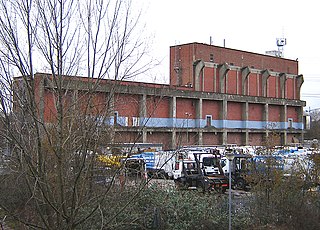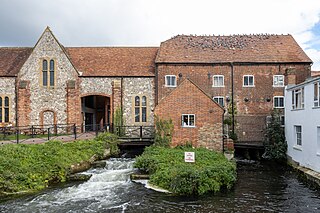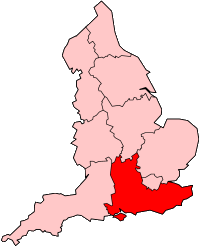
Brimsdown Power Station was a coal-fired power station on the Lee Navigation at Brimsdown in Middlesex. The station had seven cooling towers which were visible from a wide area.

West Ham Power Station was a coal-fired power station on Bow Creek at Canning Town, in east London. It was often referred to informally as Canning Town Power Station.

Keadby Power Stations are a pair of natural gas-fired power stations near Scunthorpe in North Lincolnshire, built on the site of an older coal power station. The site lies near the B1392 and the River Trent, and the Scunthorpe-Grimsby railway. Also nearby is the Stainforth and Keadby Canal, which is part of the Sheffield and South Yorkshire Navigation. The current stations are operated by SSE Thermal.

Peterborough Power Station is a 360MW gas-fired power station at Eastern Industry, Fengate in the city of Peterborough, Cambridgeshire in the United Kingdom. It employs around forty people.

Little Barford Power Station is a gas-fired power station just north of the village of Little Barford in Bedfordshire, England. It lies just south of the A428 St Neots bypass and east of the Wyboston Leisure Park. The River Great Ouse runs alongside. It was formerly the site of two coal-fired power stations, now demolished. The station is operated by RWE.

Great Yarmouth Power Station is combined cycle gas turbine power station on South Denes Road in Great Yarmouth in Norfolk, England, with a maximum output of 420 MW electricity, opened in 2001. It is built on the site of an oil-fired power station, built in 1958 and closed and demolished in the 1990s. A coal-fired power station was built in Great Yarmouth in 1894 and operated until 1961. The station is operated by RWE.

Taylors Lane Power Station is situated in Willesden, north-west London. The first power station on the site, known as Willesden power station, was coal-fired and operated from 1904 to 1972 and was subsequently demolished. Taylors Lane is now an open cycle gas turbine (OCGT) power station built in 1979.

Hackney Power Station was a coal-fired power station situated at Lea Bridge on the River Lee Navigation in London.
Hayle Power Station was a coal-fired power station situated at the mouth of the River Hayle, at Hayle in Cornwall, South West England.
Watford Power Station was a coal-fired power station situated in Watford's Riverside area. The station was built by the Watford Corporation Electricity Department starting with the installation of cables in 1899 with completion around 1900, near the banks of the River Colne. A gas turbine power station was commissioned in 1980.
The Worcester Power Stations were a series of hydro-electric and coal-fired generating stations providing electricity to the City of Worcester.
The Norwich power stations were a sequence of electricity generating stations that provided electric power to the City of Norwich and the wider area between 1893 and 1986. The first station in Duke Street began operating in 1893, a new power station at Thorpe was in service from 1926 to 1967, this was supplemented with a 'high pressure' station, 1937–1975, and finally a gas turbine station operated from 1964–1986.
Blackburn power stations are a series of electricity generating stations that have provided electric power to the town of Blackburn and the wider area from 1895 to the present. The first station in Jubilee Street, Blackburn began operating in 1895. A new larger station known as Blackburn East or Whitebirk power station was commissioned in 1921 and was rebuilt in stages over the period 1942 to 1955. Whitebirk station closed in 1976. The 60 MW Blackburn Mill Combined Cycle Gas Turbine (CCGT) power station has generated electricity since 2002. The Blackburn energy from waste (EfW) plant is currently (2020) being planned.

Leicester power stations are a series of electricity generating stations that have provided electric power to the City of Leicester and the wider area from 1894. The first station, located within Aylestone gas works, supplied electricity for street lighting. The city's new electric tram system was supplied from 1904 by a station at Lero which operated until 1930. A large coal-fired power station was constructed at Freemans Meadow in 1922 and was operational until 1976. Finally a gas turbine power plant was commissioned in 1976.
The Lancaster power stations provided electricity to the Lancashire town and city of Lancaster and the surrounding area from 1894 to 1976. The first power station was built and operated by Lancaster Corporation and started generating electricity in April 1894. The second power station was built during the First World War near the Lune Aqueduct to provide electric power for a munitions factory. When the factory closed after the war the power station was purchased by the corporation to provide electric power throughout its supply area.
Portsmouth power station supplied electricity to Portsmouth and the surrounding area from 1894 to until 1977. The power station was built and operated by Portsmouth Corporation and started supplying electricity on 6 June 1894. It was located in St Mary Street and was redeveloped several times: including major rebuilds in 1927–29 and in 1938–1952, and expanded into a larger plot. The power station was closed in 1977; the two chimneys were demolished in 1981 and the main buildings in 1982.
Sculcoates power station supplied electricity to Kingston upon Hull and the wider East Yorkshire area from 1898. An earlier 1893 station in Dagger Lane had operated public lighting in Hull Old Town. Sculcoates power station was built and operated by Kingston upon Hull Corporation on a site in Sculcoates Lane adjacent to the Beverley and Barmston Drain. The power station was increased in size as demand for electricity grew, it was redeveloped several times: including major rebuilds in 1927–29 and in 1938–1952. The power station was closed in 1976 and was subsequently demolished.
The Thornhill power station generated and supplied electricity to the town of Dewsbury and the wider regional area from 1902 to 1982, and again from 1998. The first generating station on the site was owned and operated by the Yorkshire Electric Power Company. Following nationalisation of the British electricity supply industry in 1948 Thornhill power station was operated by a succession of state owned bodies. The power station was redeveloped with new plant in 1915, 1925, 1932–37 and 1950–54. The coal-fired steam station was decommissioned in 1982, and was subsequently demolished. A gas turbine power station on the site was commissioned in 1998.

Salisbury power station supplied electricity to the English city of Salisbury and the surrounding area from 1898 to c. 1970. It was owned and operated by Salisbury Electric Light and Supply Company Limited prior to the nationalisation of the British electricity supply industry in 1948. The power station was redeveloped several times to incorporate new plant to replace retired equipment. The facilities included a water driven turbine.
Wolverhampton power station, also known as Commercial Road power station, supplied electricity to the Borough of Wolverhampton, England and the surrounding area from 1895 to 1976. It was redeveloped in several stages to meet growing demand for electricity: including the addition of new plant in 1902 to 1908, 1925 and 1942. The power station was initially owned and operated by Wolverhampton Corporation, but was transferred to the West Midlands Joint Electricity Authority in 1928. The British Electricity Authority assumed ownership at nationalisation in 1948. Wolverhampton power station was decommissioned in 1976.













